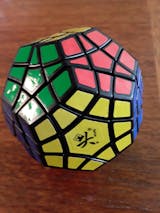When I bought this, I thought it was a 4-color version of Tutt-Minx puzzle. That one has pentagon and hexagon faces too (classic American soccer-ball / international foot-ball shape). But this one I soon learned is very different. The other puzzle has every pentagon (5 sided polygon) completely surrounded by hexagons (6 sided polygon) -- but this puzzle is the 'opposite', every hexagon is completely surrounded by pentagons! Very unique shape!
This puzzle has 4 hexagon faces (each a different color) and 12 pentagon faces for a total of 16 faces (hence the name, hexadecagon). It seems like it should be easier than Tutt-Minx which has 32 faces (12 pentagons and 20 hexagons), but I found it just as challenging -- for reasons some people may not like...
The most obvious thing when you get it is there are only 4 colors but 16 faces. If there were 4 kinds of polygons that might be okay, but since only two types, there are a lot of duplicates, or at least 'almost duplicates'.
Some people may like the challenge, but I personally don't like when the same colors are used multiple times on the same puzzle (unless assigned to different shapes, but here duplicates do apply to the same shapes). The problem with most such puzzles is you have to pay close attention to the order of the colors on a piece -- red / green / blue has a very different place than similar red / blue / green. Such puzzles make me spend FAR more time than I would prefer checking colors before executing a move. It makes things more challenging -- but in a way I find frustrating and not fun to play.
However, the triangular edge pieces are quite independent so the duplicates make the puzzle easier. The trapezoid edge pieces have only 1 orientation, and they are not hard to place. When accounting for orientation of them, you still have a pair of duplicates for each which again makes things easier. The final issue is the corner pieces. All corner pieces are completely interchangeable. Again things could be very annoying with color-ordering described before, but a neat fact = trick that I soon discovered is there are 4 corner 'types' differing by missing color.
Confused? Let me explain: each corner has 3 different colors, but since there are only 4 colors, it means each corner is missing 1 color. As such, you can classify each corner by the missing color. There are 28 corners, 7 for each class. Most = 6 of a color class have the same color-order, for example red/green/blue while a rare 1 of a color class is different ; in this example red/blue/green. What I did was place all 4 (only four!) 'rare' corners to their proper place, so I never had to think about color-order for the remaining corners while solving the rest of the puzzle!! (You do still need to orient each corner piece)
Besides limited colors described above, the next most obvious issue is bandaging. Many (most?) twisty puzzles don't have bandaging issues so this can surprise the unexpecting player! If you don't know, this means that some moves which seem possible are not possible -- trying such moves will cause the puzzle to lock-up or pop pieces. The puzzle I received didn't have any instructions on which moves are legal and which are not. Probably because trying to describe them would be difficult ?!
Again this puzzle is similar to Tutt-Minx which only allows hexagon faces to be turned twice (instead of one turn) = 6 (hexagon) / 2 = 3 legal orientations of each hexagon. With this puzzle, hexagons can be turned freely, but the pentagons are bandaged! But things are more complex: any of the 5 orientations of pentagon are 'legal', however only 1 position allows all 5 adjacent faces to turn freely. In other orientations, zero (0), one (1), or three (3) adjacent faces may turn freely. This is the most tricky part to learn. My rule: when turning a pentagon, be sure trapezoid edge-pieces align with a hexagon (if you want to turn an adjacent hexagon) and/or the triangular edge-pieces align with a pentagon (if you want to turn an adjacent pentagon).
The stickers seem durable, but a few were not well-placed and were rubbing / curling out-of-the box and a few more began to curl while playing.
The puzzle turns remarkably smoothly considering complexity, even allows some corner-cutting. I never had any pieces pop, and it rarely jammed except when I ignored the bandaging rules (in which case it almost always jams).
The size is about perfect; a bit larger than the MegaMinx that I own, but smaller than my Master KiloMinx (and Void Tutt-Minx).
In summary, if you can tolerate bandaged puzzles with duplicate colors, then you should find this one a decent challenge. If you're an experienced solver, it might not be much of a challenge once you learn the bandage rules. Also the stickers should be better for the price. In any case, it turns well enough, is well-sized, and has a very unique shape. I enjoyed it and give it four stars.







